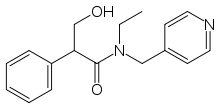Tropicamide
 | |
| Clinical data | |
|---|---|
| Trade names | Mydriacyl, others |
| AHFS/Drugs.com | Monograph |
| Pregnancy category |
|
| Routes of administration | topical eye drops |
| ATC code | |
| Pharmacokinetic data | |
| Protein binding | 45% |
| Identifiers | |
| |
| CAS Number | |
| PubChem CID | |
| IUPHAR/BPS | |
| DrugBank | |
| ChemSpider | |
| UNII | |
| KEGG | |
| ChEMBL | |
| ECHA InfoCard | 100.014.673 |
| Chemical and physical data | |
| Formula | C17H20N2O2 |
| Molar mass | 284.353 g/mol |
| | |
Tropicamide, sold under the brand name Mydriacyl among others, is a medication used to dilate the pupil and help with examination of the eye.[1] Specifically it is used to help examine the back of the eye.[2] It is applied as eye drops. Effects occur within 40 minutes and lasts for up to a day.[1]
Common side effects include blurry vision, increased intraocular pressure, and sensitivity to light. Another rare but severe side effects is psychosis, particularly in children.[1] It is unclear if use during pregnancy is safe for the baby.[3] Tropicamide is in the antimuscarinic part of the anticholinergic family of medication. It works by making the muscles within the eye unable to respond.[1]
Tropicamide was approved for medical use in the United States in 1960.[1] It is on the World Health Organization's List of Essential Medicines, the most effective and safe medicines needed in a health system.[4] The wholesale cost in the developing world is about 4.19 to 4.55 USD per 15 ml bottle.[5] In the United States a course of treatment costs less than 25 USD.[6]
Medical use
Tropicamide is an antimuscarinic drug that produces short acting mydriasis (dilation of the pupil) and cycloplegia[7] when applied as eye drops. It is used to allow better examination of the lens, vitreous humor, and retina. Due to its relatively short duration of effect (4–8 hours), it is typically used during eye examinations such as the dilated fundus examination, but it may also be used before or after eye surgery. Cycloplegic drops are often also used to treat anterior uveitis, decreasing risk of posterior synechiae and decreasing inflammation in the anterior chamber of the eye.
Tropicamide is occasionally administered in combination with p-hydroxyamphetamine (brand name Paremyd), which is a sympathomimetic. The use of the sympathomimetic drug causes the iris dilator muscle to be directly stimulated, causing increased dilation. In the United States, the sympathomimetic drop most commonly used along with tropicamide, is 2.5% phenylephrine hydrochloride (brand name AK-Dilate).
Side effects
Tropicamide induces transient stinging and a slight and transient rise in intraocular pressure in the majority of patients. It may cause redness or conjunctivitis (inflammation) and also blurs near vision for a short while after instillation (care must be taken, and the patient must only drive when vision returns to normal). Tropicamide may, in very rare cases , cause an attack of acute angle-closure glaucoma. This tends to be in patients with narrow anterior chamber angles, and closure risk must be assessed by the practitioner prior to instillation.
Tropicamide is often preferred to atropine because atropine has a longer half-life, causing prolonged dilation and blurry vision for up to a week. Atropine has less sting effect, but can be toxic or fatal if ingested in large quantities by children or adults.
Systemic side effects are very rare.
Illicit use
According to the researchers of the European Commission-funded ReDNet Project, in Russia tropicamide is currently abused (injected intravenously) as an inexpensive recreational deliriant drug.[8] It is usually mixed with heroin, methadone, and other opioid drugs to potentiate the "rush" when injected intravenously.[9]
References
- 1 2 3 4 5 "Tropicamide". The American Society of Health-System Pharmacists. Retrieved 8 December 2016.
- ↑ WHO Model Formulary 2008 (PDF). World Health Organization. 2009. p. 314. ISBN 9789241547659. Retrieved 8 December 2016.
- ↑ "Tropicamide ophthalmic Use During Pregnancy | Drugs.com". www.drugs.com. Retrieved 28 December 2016.
- ↑ "WHO Model List of Essential Medicines (19th List)" (PDF). World Health Organization. April 2015. Retrieved 8 December 2016.
- ↑ "Tropicamide". International Drug Price Indicator Guide. Retrieved 8 December 2016.
- ↑ Hamilton, Richart (2015). Tarascon Pocket Pharmacopoeia 2015 Deluxe Lab-Coat Edition. Jones & Bartlett Learning. p. 415. ISBN 9781284057560.
- ↑ Manny RE, Hussein M, Scheiman M, Kurtz D, Niemann K, Zinzer K (July 2001). "Tropicamide (1%): an effective cycloplegic agent for myopic children". Investigative Ophthalmology & Visual Science. 42 (8): 1728–35. PMID 11431435.
- ↑ Bersani, F. S.; Corazza, O.; Simonato, P.; Mylokosta, A.; Levari, E.; Lovaste, R.; Schifano, F. (2013). "Drops of madness? Recreational misuse of tropicamide collyrium; early warning alerts from Russia and Italy". General Hospital Psychiatry. 35 (5): 571–3. PMID 23706777. doi:10.1016/j.genhosppsych.2013.04.013.
- ↑ Krokodil: The drug that eats junkies